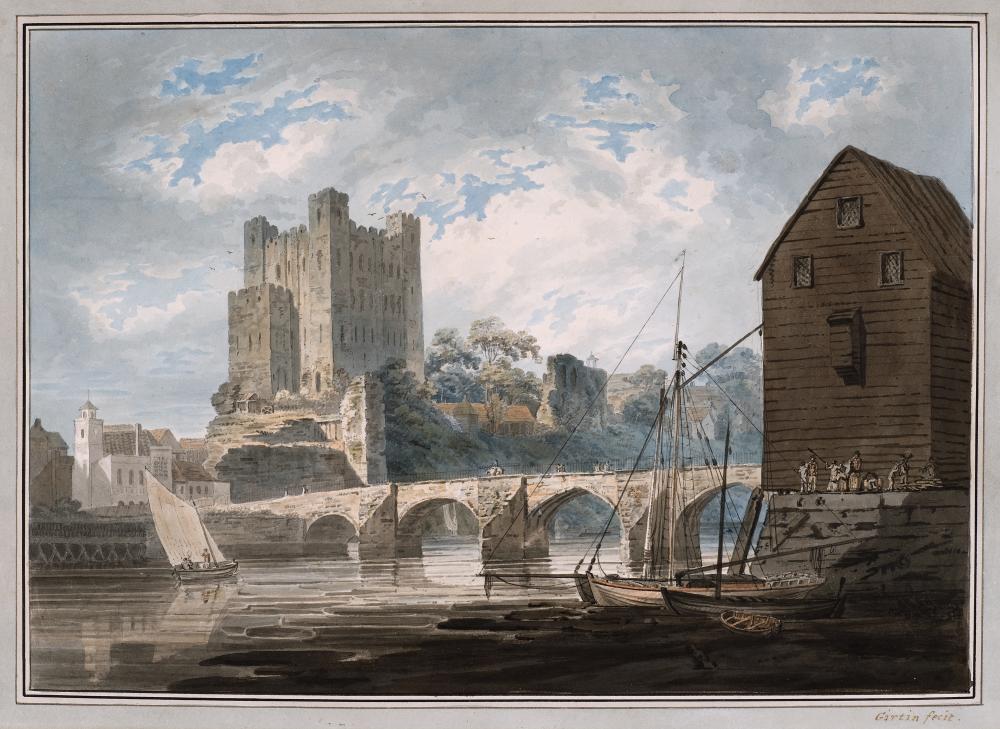J.M.W. TURNER R.A.
(1775-1851)
Chepstow Castle on the river Wye, Monmouthshire
signed and dated 'Turner 1794' (lower left)
Provenance
Dr Thomas Monro (1759-1833)
His sale, Christie's, London, 26th-28th June & 1st-2nd July 1833, 1st day of sale, lot 128
Collection of William Leaf (d.1874) of Park Hill, Streatham, by 1862
His sale, Christie's, London, 7th May 1875, lot 376, bt. Agnew for £168
Collection of Sir Joseph Heron (1809-1889)
His sale, Christie's, London, 9th June 1890, lot 75, bt. Walford for £29 8s.
Collection of David Jardine (1827-1911) of High Lee, Woolton, Liverpool
His sale, Christie's, London, 16th March 1917, lot 58, bt. "AJG" according to a label affixed to the reverse (possibly a member of the Gibson family)
The Hon. Mrs Rupert Blyth (née Charlotte May Gibson, 1891-1956) by 1956
Acquired from her estate by the wife of her cousin George Cock Gibson, Mrs Angela Madeleine Gibson (1896-1993),
for £280
Thence by family descent
Exhibited
London, The International Exhibition, 1st May-1st November 1862, no. 1041 as ‘Chepstow (drawing), lent by W. LeafLiterature
Copper-Plate Magazine, vol. 2, pl. 67, engraving of 'Chepstow' by J. Storer, published 1st November 1794
Andrew Wilton, J.M.W. Turner: His Art and Life, 1979, p. 311, not illustrated
The present watercolour can be identified with the one previously recorded by Alexander Joseph Finberg (1866-1939) and referred to in Wilton’s catalogue (see Literature, Wilton, p. 311), but which has until now been untraced. In his manuscript card index of Turner’s watercolours in private and public collections, now in the Print Room of the British Museum, Finberg recorded a drawing of this subject and of identical dimensions with provenance to Dr Monro, Leaf and Heron which clearly matches that of the present work. The subject of Chepstow Castle and bridge was one of sixteen scenes commissioned from Turner to be engraved for John Walker’s Copper-Plate Magazine between 1794 and 1798. This was the first time Turner was asked to supply a set of topographical views for a publication. Whilst Turner planned his Midland tour of 1794 with the intention to collect material for this venture, he would have equally drawn on landscape subjects from his earlier tours. No sketches of this composition are known, however, the Turner Bequest, now at Tate Britain, contains two pencil drawings of Chepstow (D40034, D00130) which are dated to Turner’s visit in 1792. The present view was therefore most likely inspired by Turner’s tour of Wales of June-July 1792, which could be considered his first independent tour, or his subsequent 1793 tour of the Welsh Marches which took him to many places he had visited the previous year, including the Wye valley. The tours provided Turner with the raw material from which he could develop his subjects in watercolour in his studio on his return to London. This composition is known to exist in two versions with significant variations - the present, larger and noticeably more finished version dated 1794; and another, smaller (20.3 x 29.7cm) and undated version which is now at the Courtauld Institute of Art Gallery, London (D.1974.STC.1). The differences can be observed in the arrangement of the boats, the delineation of the town and castle, and the positioning of the figures on the bridge. Both versions also appear to differ, to a varying extent, from the engraving of this subject by James Storer for the Copper-Plate Magazine (see Literature), though the Courtauld version is more like the subject for the engraving (see Wilton, p. 311). The present version, being large-scale and highly worked up, might have been intended as a presentation piece to a patron, such as Dr Thomas Monro who was to become one of Turner’s most important patrons. We are grateful to Andrew Wilton for his assistance with this catalogue note.


